San Antonio now has one more attraction as the San Antonio Aquarium- Sea to Believe opened to the public on December 17, 2014. Located at 6320 Bandera Road, they have a number of different fish and other marine animals, tropical and saltwater, several different species of reptile, lorikeets, macaws, and a Jurassic Jungle exhibit. The San Antonio Aquarium is owned mainly by Vince Covino, who also owns the Portland Aquarium and the Austin Aquarium.
The first thing that you see once you walk into the aquarium are a few large animatronic dinosaurs. Their heads and tails move occasionally, but other than that there is nothing else to them. There are no signs or graphics of which dinosaur is which or anything else that would help indicate which one it is.
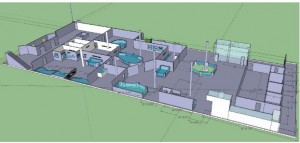
Photo by www.mysanantonio.com
Going further into the aquarium, on a wall, there are three tidal pool tanks for guests to look at. Inside the tanks are only a few small fish with barely any plants or other decorations, along with a few sea stars. In another wall there was a couple of small wall tanks containing a few fish, although there was only a small display screen that showed brief slides of information on a few of the fish inside the tanks, the information was basic and lacking.
The next room that you walk into has literally nothing. It had two small tables and a couple of chairs, with nothing else to look at.
After the barren room is Stingray Cove, a large stingray touch tank where guests can actually touch a few different species of stingray. For a few dollars, people can buy food so they can feed the rays if they choose. While the majority of the cownose stingrays were extremely friendly, the other majority of rays stayed in the center of the pool, away from the people. Here, once again, there was no information on what kinds of rays were in the tank.

Photo by www.wordnik.com
On each side of the large stingray pool were more wall tanks with small tropical fish. Each tank typically had one or two different species inside. Although, each tank had an unnecessary amount of fish in consideration to the tank space. There was a small display for information, but, just as before, the information was extremely lacking.
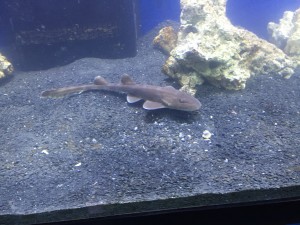
Photo by Frank Garcia
Next to the wall tanks on the side of the Stingray Cove, there is a tank that houses a large spotted moray eel, a puffer fish, and three lion fish. Inside the tank, the spotted moray, very quickly growing to be as long as the tank, was attempting to hide its large body inside some fake coral that was much too small. This species of moray eel typically hides its whole body inside coral, with the exception of its head. There were also no signs to say what was in the tank.
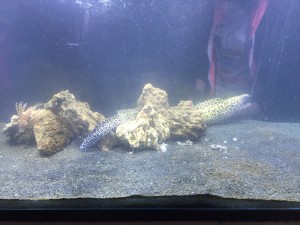
Photo By Frank Garcia
Going past the stingrays, the next room is the aquariums rainforest room. Inside, were two shin-high tanks with huge schools of young koi fish. There is also a large tank of tropical fish that had steps leading up to it so that guests could feed the fish. On both of these tanks, there were no displays of information.
On the other side of the room were the aquarium’s collection of reptiles. There are different species of iguana and other lizards, caimans, and a large Burmese python. There are also two very large macaws out for people to see and possibly touch, and two large cages full of lorikeets that people could walk into.
Unfortunately, most of the reptiles inside the wall tanks were either too big for the tank or soon to be too big for the tank. There was also an enclosure that had an adult tegu, a large, typically aggressive predatory land lizard, with two baby caimans in the water. The land was barely big enough for the tegu to be on, so when the caimans grow older, there will be fights between them and the tegu for space.
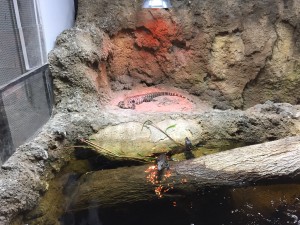
Photo by Frank Garcia
Inside the same room was a large cage for different species of iguanas that people could walk into. There was a large number of iguanas, all of which were at the highest corner of the cage away from people. Next to the cage was a large green iguana lying on a bed of fake grass under a heating lamp with lettuce at its face for people to come up and touch. There was no employee next to the iguana to make sure that people weren’t rough with it or to make sure it and the guests were safe.
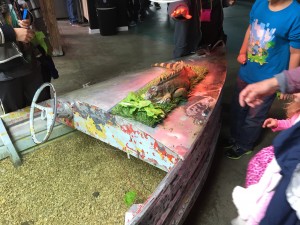
Photo by Frank Garcia
At the end was the gift shop, which was brightly colored and fully stocked. The gift shop was totally finished and clearly had more attention paid towards it than any of the animal facilities.
After seeing the whole aquarium, you could walk back through it to see all of the exhibits again on your way out. In the room with the tidal pool tanks, there is one tank that most people will miss. This tank contains the main attraction of the whole aquarium, the Giant Pacific Octopus. The tank was small and there was no where for the octopus to hide. It was also an open top aquarium, which is not great for an octopus as they are highly intelligent creatures that can get out of a totally sealed tank. The octopus inside barely moved and was discolored from its normal shade of red. Octopi can change their color to hide, but this was more of a sickly color.

Photo by Frank Garcia
Overall, most of the tanks or enclosures had too many animals for just one tank, or the tanks were too small for the animals inside them. The overall care for the animals, specifically the reptiles and birds, was poor and bare minimum. There was also very little or no information at all explaining what animals were in the exhibits and if there was, the information was extremely basic.
I would not recommend going to the San Antonio Aquarium.








Heard of the aquarium opening in late September, I was really excited.
After reading this article http://www.mysanantonio.com/news/local/article/San-Antonio-Aquarium-owners-under-investigation-5716516.php my doubts whether the aquarium would be legitimate turned to disgust after reading your review. I hope someone does something to close this place down, or have it taken under new ownership.
So, Frank, are you or any other residents of San Antonio going to stand up for these animals? At the very least alert PETA or the local Animal Welfare Agency for a look see? Who approved their operating permit? Have any animal science friends, veterinarians, or zoo people you could contact? Reputable zoos or other organizations should care to have these kinds of horrible places shut down. Don’t just write a review, my friend, do something for those poor animals!!